Lego opens its first Superpower Studios at Paris’ La Gaîté Lyrique
In collaboration with Lego’s new Global Play Ambassadors, artists Aurélia Durand, Chen Fenwan and Ekow Nimako, and overseen by Colette co-founder Sarah Andelman, Paris is the site of the first Lego Superpower Studios

Behind the grand façade of La Gaîté Lyrique, a former theatre-turned-digital experience centre in Paris’ 3rd arrondissement, is a new installation by the Lego group. The first Superpower Studios brings together the work of three contemporary artists, overseen by Lego’s global VP of brand development Alero Akuya, and Colette co-founder-turned-creative consultant Sarah Andelman.

Lego Superpower Studios (or L'Atelier des Super-Pouvoirs) at La Gaîté Lyrique, Paris
First and foremost, this is a show for the kids, carefully assembled to cater to a child’s point of view and born from a series of play workshops held at the Lego House in the company’s Danish hometown of Billund. Lego is serious about play, and creative collaboration, and these aspirations are becoming more and more evident as the company reaches out to embrace creatives from all spheres around the world.

Superpower Studios: the gallery
Its ‘Rebuild the World’ campaign, launched in 2019, continues to influence how the company approaches its audience, young and old. In recent years, we’ve noted collaborations with the likes of Dara Huang, Yinka Ilori and Camille Walala, giving the humble Lego brick a totemic role in all kinds of creative endeavours.

Lego's Alero Akuya in front of a sculpture by Chen Fenwan
One reason for Lego’s rising stock among the creative community is the influence of Akuya. A former long-termer at Nike, where she was senior brand director of Olympics, Athlete and Purpose Marketing in North America, Akuya is a magnificent and enthusiastic spokesperson for the company. ‘It’s probably the most experiential brand in the world – so how do you demonstrate that at scale?’ she says, adding that ‘there’s always a wow factor with Lego. It’s about creative problem-solving.’

Lego's Alero Akuya and creative advisor Sarah Andelman
More importantly, the project demonstrates Lego’s universal engagement. For the ambassadors, Akuya explains that ‘we wanted global representation, as well as people who have worked with children and communities. Play is a source of social inclusion – that was very important to us.’ To this end, the three chosen artists cross cultures as well as methodologies and approaches.
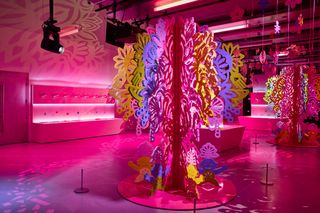
Chen Fenwan's ‘Forest of Wishes’
All were briefed to create something that ‘reimagined traditional norms’ for a gallery space – hands-on interaction is firmly encouraged at Superpower Studios. Most importantly, the installations are free and aimed squarely at families, addressing the company’s recent research that shows that 40 per cent of families around the world ‘lack access to adequate or safe spaces to play and 76 per cent of parents believe children have less time to play’.

The play area within Ekow Nimako's ‘Mythical Maze’
It's play, but it’s also taken very seriously by the Danish company. Founded in 1934, with a name that famously derives from the Danish phrase to ‘play well’, Lego's plastic blocks have been an integral part of the modern world since 1949. Now a global behemoth, with a net profit of DKK 13.1bn ($1.9bn) in 2023, Lego also has a clutch of ultra-high-profile licence agreements and a continuous flow of new ideas, innovations and products.
Wallpaper* Newsletter
Receive our daily digest of inspiration, escapism and design stories from around the world direct to your inbox.

Sarah Andelman in the gallery space
The Superpower Studios start with a gallery space, a spread of blank stud-board canvases on which visitors can create their own portrait. ‘It means you are an artist as well – you can participate right from the start,’ says creative advisor Andelman. She has parlayed her love of storytelling into four installations, starting with this gallery space and progressing through worlds created by each individual ambassador. ‘Sadly, there’s no gift shop,’ she says, revealing her retail experience. ‘I really tried though,' she adds wistfully. Parents might be thanking her.

Chen Fenwan in her ‘Forest of Wishes’ installation
It's hard to imagine how to monetise Chinese artist Chen Fenwan’s installation. A series of large Lego sculptures mimicking the forms, figures and creatures she makes from her paper-cut artwork, the room is bathed in shifting patterns of light. This ‘Forest of Wishes’ combines traditional art form with a place from Chinese folklore, all filtered through the little bricks’ abilities to shape-shift into any form you like.
‘When I was a little kid, I couldn’t afford Lego,’ Fenwan tells us. ‘I got my first set when I was a teenager.’ As a self-taught artist, Fenwan has created her own style of paper cut, painting on special paper and working with the power of the silhouette. ‘Paper cutting is about omission – the shadow must be a part of the work,’ she says, ‘it’s an art about light.’ Luckily, it’s also a world of colour, with pink and other pastels dominating the large space (a smell of warm polymers also permeates everything – few other brands are so culturally, technically and practically wedded to the use of plastic in perpetuity).
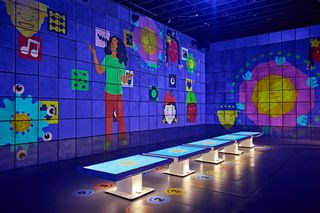
The ‘Remix Room’, by Aurélia Durand
A pair of double doors leads into Aurélia Durand’s space, the ‘Remix Room’. Another self-taught artist, Durand studied product design in France and Denmark before becoming an illustrator, teaching herself animation in order to bring her vibrant, bold drawings to life. Of all the installations, it’s Durand’s that puts play closest to its heart, even if children won’t actually be touching any Lego blocks at all.

Animator and illustrator Aurélia Durand
The tall, rectangular room is swathed in a grid of screens, with a row of touchscreen tables arranged in the middle, set at a child-friendly height. On these, a series of simple mini-games can be played, each of which encourages collaboration with your opposing number.

Aurélia Durand's 'Remix Room'
Durand’s artistic style carries through to every surface. Her work, which includes illustrating Tiffany Jewell’s best-selling This Book is Anti-Racist, is a perfect fit for the brand. ‘My work is about colour, joy and playfulness – these things are the DNA of Lego,’ she says. ‘As a child, Lego stimulated my creativity. I played with it for hours – it’s a major influence from my childhood.’
During a research trip to Billund, Durand noted the social power of play. ‘Play makes you grow as a person – I was inspired by the collaborative process [of the children in the workshops]. It’s important not to lose the social link. Children need to build with others.’

Ekow Nimako in his installation, ‘The Mythical Maze’
Ekow Nimako is a Ghanaian-Canadian artist, musician and novelist, the only one of the three ambassadors who had previously worked with Lego. Nimako’s sculptures frequently use black bricks to create elaborate Afro-Futurist forms, drawing on mythological creatures and science fiction visions. His installation at Superpower Studios, ‘The Mythical Maze’, would be a fearsome experience for smaller, more timid children, a plastic jungle with piped-in wildlife noises and scattered imagery from his own work.

The entrance to Ekow Nimako's ‘Mythical Maze’
Like the others, Nimako played with Lego as a small child but then rediscovered it. ‘I became a musician, but then at art school I dabbled in Lego again – it got me back into that world,’ he says. ‘I also discovered that people had Lego-based careers.’ Nimako didn’t have a formal relationship with Lego until 2022, but for many years before that, his work used the bricks as a primary material.

‘The Mythical Maze’, Ekow Nimako
‘Lego play is all about problem-solving,’ he says. ‘Play doesn’t have rules, really – it’s such a perfect material. Repurposing things is what I do. At heart, I’m a found-object artist – I would always see things contained within other objects.’
The exhibition also makes a bold statement about representation. ‘Lego is progressive,’ Nimako says. ‘It’s important that different cultures click together. Getting my work out there impacts kids, particularly racialised kids.’
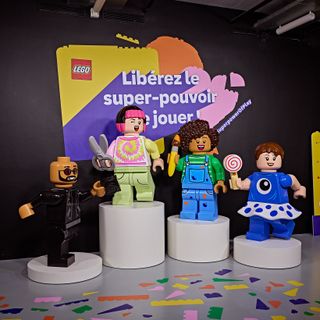
The curatorial team have their own Lego Minifigs
For decades, Lego was a toy rooted in post-war European exceptionalism, offering up pat, clichéd takes on other cultures and historical moments, as well as an idealised, utopian view of families, careers, cities, etc. Superpower Studios is an explicit open invitation to find the beauty and importance of play outside of these narrow, predefined lanes. It’s a task mirrored by other activations around the world, in China, Hungary, Germany, Japan and elsewhere, cementing the cultural importance of play within the city. ‘Kids are the core of what we do – we want to inspire and engage them,’ Akuya concludes.
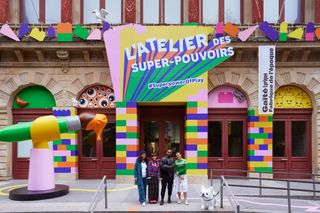
The curatorial team outside Superpower Studios
It's a shame that Superpower Studios is such a fleeting experience – a few more weeks would have opened up the world of play to hundreds more. There are also precious few places for adults to sit and just watch their children dive into the bins of different coloured bricks, as the rooms echo to that very distinctive rattle. Despite these quibbles, Superpower Studios offers up a welcome balance of culture and creativity.
Lego Superpower Studios, from Wednesday 11 – Monday 16 September 2024, La Gaîté Lyrique, Paris, free tickets available online here, Gaite-Lyrique.net, Lego.com
Sarah Andelman, JustanIdea.com
Chen Fenwan, ChenFenwan.com, @ChenFenwan
Aurélia Durand, Aurelia-Studio.com, @4ur3lia
Ekow Nimako, EkowNimako.com, @EkowNimako
Jonathan Bell has written for Wallpaper* magazine since 1999, covering everything from architecture and transport design to books, tech and graphic design. He is now the magazine’s Transport and Technology Editor. Jonathan has written and edited 15 books, including Concept Car Design, 21st Century House, and The New Modern House. He is also the host of Wallpaper’s first podcast.
-
 ‘If kids grew up going to London Design Festival they would learn so much’: architect Shawn Adams
‘If kids grew up going to London Design Festival they would learn so much’: architect Shawn AdamsIn the first of our interviews with key figures lighting up the London Design Festival 2024, Shawn Adams, founder of POoR Collective, discusses the power of such events to encourage social change
By Ali Morris Published
-
 Discover London’s lesser-known design gems with ‘an opinionated guide’
Discover London’s lesser-known design gems with ‘an opinionated guide’‘An opinionated guide to Design London’ by Sujata Burman and Wallpaper’s Rosa Bertoli is a carefully curated tour of intriguing design spots across the capital
By Tianna Williams Published
-
 Hill House Montecito is a flowing home 'for the twenty-first century'
Hill House Montecito is a flowing home 'for the twenty-first century'Hill House Montecito by Donaldson + Partners brings together a client's vision with architectural drama and a site-specific approach for a California family home
By Ellie Stathaki Published
-
 Behind the scenes: how the Paris 2024 Olympic and Paralympic Torches, Rings, and Agitos came to life
Behind the scenes: how the Paris 2024 Olympic and Paralympic Torches, Rings, and Agitos came to lifeArcelorMittal’s three-part video series offers a first look behind the scenes of how the Paris 2024 Olympic and Paralympic creative vision was ignited
By Tianna Williams Published
-
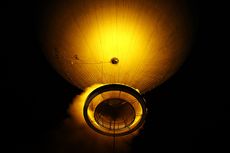 Take off: Mathieu Lehanneur's Olympic Cauldron rises into the Parisian night sky
Take off: Mathieu Lehanneur's Olympic Cauldron rises into the Parisian night skyThe Paris 2024 Olympics’ opening ceremony was closed with a soaring cauldron spectacle that will go down in history
By Hugo Macdonald Published
-
 Postcard from Paris: Olympic fever takes over the streets
Postcard from Paris: Olympic fever takes over the streetsOn the eve of the opening ceremony of Paris 2024, our correspondent shares her views from the streets of the capital about how the event is impacting the urban landscape.
By Minako Norimatsu Published
-
 Designing the Olympics: Wallpaper* interviews Joachim Roncin, director of design for Paris 2024
Designing the Olympics: Wallpaper* interviews Joachim Roncin, director of design for Paris 2024How do you begin to design the Olympics? We pulled up a pew with the director of design for Paris 2024 to learn more about gender-free mascots with a genital likeness and medals made from the Eiffel Tower
By Hugo Macdonald Published
-
 Inside design salon Matter and Shape’s first edition
Inside design salon Matter and Shape’s first editionThe inaugural edition of Matter and Shape, held at the Jardin des Tuileries in early March 2024, brought together brands, designers and craftspeople in a unique design salon
By Minako Norimatsu Published
-
 Sarah Andelman’s new pop-up at Le Bon Marché is all about the universe of books
Sarah Andelman’s new pop-up at Le Bon Marché is all about the universe of booksSarah Andelman presents Mise en Page at Paris' Le Bon Marché, a pop up of curiosities featuring products and installations celebrating books (until 21 April 2024)
By Minako Norimatsu Published
-
 Andrée Putman’s Paris loft is the stage for Nigerian artist Jamiu Agboke’s work
Andrée Putman’s Paris loft is the stage for Nigerian artist Jamiu Agboke’s workTake an exclusive look inside Andrée Putman’s Paris loft as it forms the backdrop to Jamiu Agboke’s work, for an exhibition by art adviser Valerio Polimeno and gallery VIN VIN
By Minako Norimatsu Published
-
 Paris Design Week 2024: the highlights
Paris Design Week 2024: the highlightsThe best of Paris Design Week 2024, from chic takeovers to new launches of furniture, wallpapers and textiles
By Rory Robertson Published